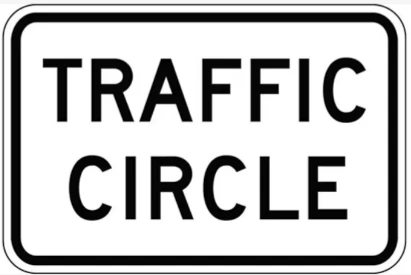 Question: I live near a small traffic circle at Peatt and Brock Roads in Langford. What often happens is a large volume of traffic flows south down Peatt Road and proceeds straight through. There can be 10 or 15 cars in a row. Meanwhile, there will be a vehicle on Brock Road waiting for a break in traffic to proceed into the circle.
Question: I live near a small traffic circle at Peatt and Brock Roads in Langford. What often happens is a large volume of traffic flows south down Peatt Road and proceeds straight through. There can be 10 or 15 cars in a row. Meanwhile, there will be a vehicle on Brock Road waiting for a break in traffic to proceed into the circle.
I have been told that this situation needs to be treated as a "lazy 4 way stop." If there is a long line of traffic that is able to flow through the circle from Peatt and a car approaches on Brock wanting enter the circle, does traffic on Peatt need to let the car on Brock enter the circle?

Traffic Circle Referred to in Question
Follow the Leader
Drivers are great at following the leader but less good at understanding and following the directions of posted signs, in this case the yield sign.
Yielding at Intersections
The Motor Vehicle Act has this to say:
Yield signs
173 (2) Except as provided in section 175, if 2 vehicles approach or enter an intersection from different highways at approximately the same time and there is a yield sign, the driver of a vehicle facing the sign must yield the right of way to all other traffic.
Section 175 deals with a stop sign and is not applicable in this instance.
ALL other traffic does not consist only of motor vehicles, it also includes cyclists and pedestrians.
Obeying the Yield Sign
When you approach the traffic circle you are facing a yield sign and must obey it. If you are southbound on Peatt and there is a car waiting patiently at the yield sign at Brock, it is part of "all other traffic" and must be yielded to along with any traffic in the circle itself.
As you suggest, it is much the same as the 4 way stop, but a stop is only required here if yielding to other traffic prevents you proceeding immediately.
Share This Article
In the section on traffic circles in the ICBC driver's education documentation it states:
When you’re using a traffic circle:
• Slow down as you approach the circle.
• Obey any posted traffic control signs, such as Yield or Stop signs. If there are no traffic control signs, treat it as an uncontrolled intersection.
• Yield to any traffic in the traffic circle. If another vehicle arrives at the traffic circle at the same time as you do, yield to the vehicle on your right.
• Go around the traffic circle to the right (that is, in a counterclockwise direction).
In practical terms I believe what this is saying is that as a driver once I'm in the circle I should be able to drive around the circle unimpeded for as long as I want, but prior to entering the circle I should yield to a vehicle on my right (and the vehicles already in the circle).
I am one of the people who would probably not yield to you in your example for the simple reason that you have to sit there and wait for the 2 or 3 cars in front of me that are already in the circle, so the circle is clear for me to enter and you are blocked by other vehicles. Once I'm in the circle, I think you have to yield to me.
- Log in to post comments
In practical terms I believe what this is saying is that as a driver once I'm in the circle I should be able to drive around the circle unimpeded for as long as I want, but prior to entering the circle I should yield to a vehicle on my right (and the vehicles already in the circle).
In the case of a Roundabout, or any other circle where the intersecting traffic is controlled by Yield signs, then certainly once in it you can go around and around forever, and expect to be given the right of way - the other drivers who could be in conflict are required to Yield because of the Yield signs. Simple and straightforward.
However, in the case of a Traffic Circle that is Uncontrolled (which will typically be much smaller with the vehicles in closer proximity) then drivers are actually required to yield to the vehicle approaching from the right which would be in conflict with them.
Now where it gets really silly, is when the local municipality who created the circle put up black and white signs on the circle advising approaching drivers that they should 'yield to traffic in circle' ... because unless they have some local bylaw in effect that over-rides the Motor Vehicle Act then their signs are utter nonsense.
- Log in to post comments
I think the City of Langford put the wrong signs here. I think these signs should be "Yield to traffic in circle" instead of conventional Yield signs. This would make more sense and fits what "DamnIHateThat" has said. Otherwise if two people arrive at this intersection at the same time and both face a yield sign, then Sec. 173(2) says that they're supposed to yield to each other?
- Log in to post comments
It's fundamentally obvious. Drivers who have not entered the intersection - in this case, a Roundabout - must not move into the intersection if there's any chance of conflict. Right of way is a simple concept, and for vehicle drivers, they don't ever 'have' the right of way but there are many instances when they are required to give that right of way to others with whom they might be in conflict.
Roundabouts are used because they're efficient (much more so than 4-Way Stops) and only require vehicles to stop and wait if there's a vehicle (or vehicles) that have entered the roundabout and are (obviously) approaching from the left. They also work well because they eliminate unnecessary stops and starts (such as at a Stop sign controlled intersection); plus which, if there is a collision then it's far less likely to cause injury to vehicle occupants than a T-bone crash.
I have been told that this situation needs to be treated as a "lazy 4 way stop."
And just what the heck is that supposed to mean?
Yield. If you proceed into the intersection, and this results in a collision with a vehicle that had already entered the roundabout, it's your fault, you broke the law. 100%. Simple concept.
- Log in to post comments
I have difficulty understanding how the protocal for navigating a "traffic circle" is much different than a roundabout that may have more signage and road markings. After all, on ICBC's Learn to drive smart Chapter 4 page 46 we are told for the traffic circle:
Yield to any traffic in the traffic circle.
The next statement about another vehicle arriving at the same time does not I think negate the above fundamental rule that applies to traffic circulars whether they are called roundabouts or traffic circles.
The problem in Langford is an example of where the volume of flow in one direction overwhelms the ability of the circle to handle flows from other approaches efficiently. I am not a traffic engineer so don't have the solution however I note that many roundabouts in busy traffic areas in the UK had to install traffic lights to allow access to the circle from approaches that had difficulty and to decrease long waits at yield signs that had resulted in increased crashes.
- Log in to post comments
I've checked Maps Google in all four directions. I don't see where the municipality has placed the yellow sign with the circular arrows, that generally denote Traffic Circles and Roundabouts.
This intersection looks more like an attempt at "Traffic Calming" by placing an obstacle in the centre of an intersection.
This is an engineering problem. What a mess.
I would say this is actually an uncontroled intersection.
Obviously not suitable for the volume of traffic.
- Log in to post comments
So this statement:
I would say this is actually an uncontrolled intersection.
Makes absolutely no sense. It's controlled by Yield signs, how can this not be obvious?
Obviously not suitable for the volume of traffic.
Really? So what traffic control design would you recommend for that neighbourhood?
Keep in mind, that even if there are 20 vehicles wishing to enter an intersection - say, 15 heading northbound and 5 heading westbound - then even if those five vehicles have to wait until the other 15 have gone by it's still going to move those 20 vehicles through that intersection sooner than anything else.
Meanwhile, going back to your previous statement, ICBC advise:
Types of intersections Controlled intersections A controlled intersection is one that has signs or traffic lights telling you what to do. To drive safely in these intersections, you need to know what the signals and signs mean, and also the right-of-way rules. But always be cautious. Other drivers may not be paying attention to the signs and signals.
- Log in to post comments
- Log in to post comments

Confessions of a traffic circle user